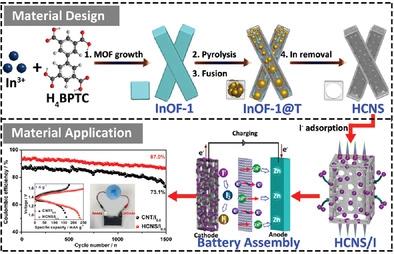Our official English website, www.x-mol.net, welcomes your
feedback! (Note: you will need to create a separate account there.)
In-MOF-Derived Hierarchically Hollow Carbon Nanostraws for Advanced Zinc-Iodine Batteries
Advanced Science ( IF 14.3 ) Pub Date : 2022-10-01 , DOI: 10.1002/advs.202105063 Lulu Chai 1, 2 , Xian Wang 1 , Yue Hu 1 , Xifei Li 3 , Shaoming Huang 4 , Junqing Pan 2 , Jinjie Qian 1, 5 , Xueliang Sun 6
Advanced Science ( IF 14.3 ) Pub Date : 2022-10-01 , DOI: 10.1002/advs.202105063 Lulu Chai 1, 2 , Xian Wang 1 , Yue Hu 1 , Xifei Li 3 , Shaoming Huang 4 , Junqing Pan 2 , Jinjie Qian 1, 5 , Xueliang Sun 6
Affiliation

|
Hollow carbon materials are regarded as crucial support materials in catalysis and electrochemical energy storage on account of their unique porous structure and electrical properties. Herein, an indium-based organic framework of InOF-1 can be thermally carbonized under inert argon to form indium particles through the redox reaction between nanosized indium oxide and carbon matrix. In particular, a type of porous hollow carbon nanostraw (HCNS) is in situ obtained by combining the fusion and removal of indium within the decarboxylation process. The as-synthesized HCNS, which possesses more charge active sites, short and quick electron, and ion transport pathways, has become an excellent carrier for electrochemically active species such as iodine with its unique internal cavity and interconnected porous structure on the tube wall. Furthermore, the assembled zinc-iodine batteries (ZIBs) provide a high capacity of 234.1 mAh g−1 at 1 A g−1, which ensures that the adsorption and dissolution of iodine species in the electrolyte reach a rapid equilibrium. The rate and cycle performance of the HCNS-based ZIBs are greatly improved, thereby exhibiting an excellent capacity retention rate. It shows a better electrochemical exchange capacity than typical unidirectional carbon nanotubes, making HCNS an ideal cathode material for a new generation of high-performance batteries.
中文翻译:

用于高级锌碘电池的 In-MOF 衍生的分层空心碳纳米管
空心碳材料因其独特的多孔结构和电学性能而被视为催化和电化学储能中的重要载体材料。在此,InOF-1 的铟基有机骨架可以在惰性氩气下热碳化,通过纳米级氧化铟和碳基质之间的氧化还原反应形成铟颗粒。特别是,通过在脱羧过程中结合熔化和去除铟,原位获得了一种多孔中空碳纳米管(HCNS)。所合成的HCNS具有更多的电荷活性位点、短而快的电子和离子传输通道,以其独特的内腔和管壁上相互连接的多孔结构成为碘等电化学活性物质的优良载体。此外,−1 at 1 A g −1,保证碘物质在电解液中的吸附和溶解迅速达到平衡。基于HCNS的ZIBs的倍率和循环性能得到极大提高,从而表现出优异的容量保持率。它表现出比典型的单向碳纳米管更好的电化学交换容量,使HCNS成为新一代高性能电池的理想正极材料。
更新日期:2022-10-01
中文翻译:

用于高级锌碘电池的 In-MOF 衍生的分层空心碳纳米管
空心碳材料因其独特的多孔结构和电学性能而被视为催化和电化学储能中的重要载体材料。在此,InOF-1 的铟基有机骨架可以在惰性氩气下热碳化,通过纳米级氧化铟和碳基质之间的氧化还原反应形成铟颗粒。特别是,通过在脱羧过程中结合熔化和去除铟,原位获得了一种多孔中空碳纳米管(HCNS)。所合成的HCNS具有更多的电荷活性位点、短而快的电子和离子传输通道,以其独特的内腔和管壁上相互连接的多孔结构成为碘等电化学活性物质的优良载体。此外,−1 at 1 A g −1,保证碘物质在电解液中的吸附和溶解迅速达到平衡。基于HCNS的ZIBs的倍率和循环性能得到极大提高,从而表现出优异的容量保持率。它表现出比典型的单向碳纳米管更好的电化学交换容量,使HCNS成为新一代高性能电池的理想正极材料。






























 京公网安备 11010802027423号
京公网安备 11010802027423号